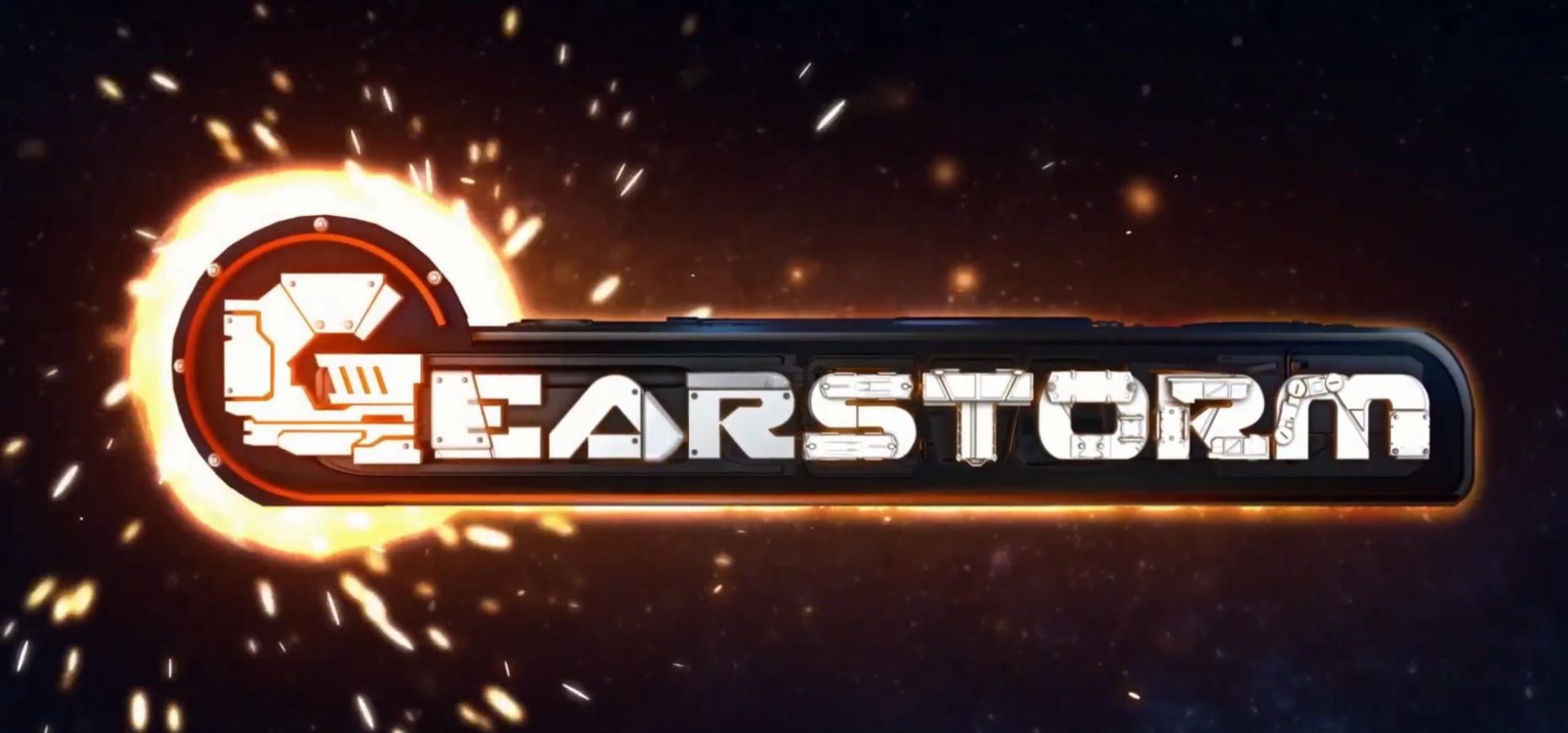While a bit clunky in places, Gearstorm has solid foundations for a large-scale survival game, and it’s already pretty addictive.
Type: Single-player, Multi-player
Genre: Action, Simulation, Strategy
Developer: Iron City Games
Publisher: Iron City Games
Release Date: 21 Nov, 2019


Introduction
Gearstorm is a single- and multi-player science-fiction survival-crafting game, recently entered into public Early Access on Steam, from Iron City Games.
Earth has been all but destroyed by a virus: the Phage. The population greatly reduced, humanity has reached towards the stars to try to find a new home. You play an Exomarine: a clone soldier sent to the planet Apollyon to prepare it for human colonisation. It’s your job to do your part in establishing the colony: harvest, mine, build, create, and defend everything from the Apollyon’s own indigenous lifeforms, as well as the Phage-infected humans that have somehow made it to the planet with you.
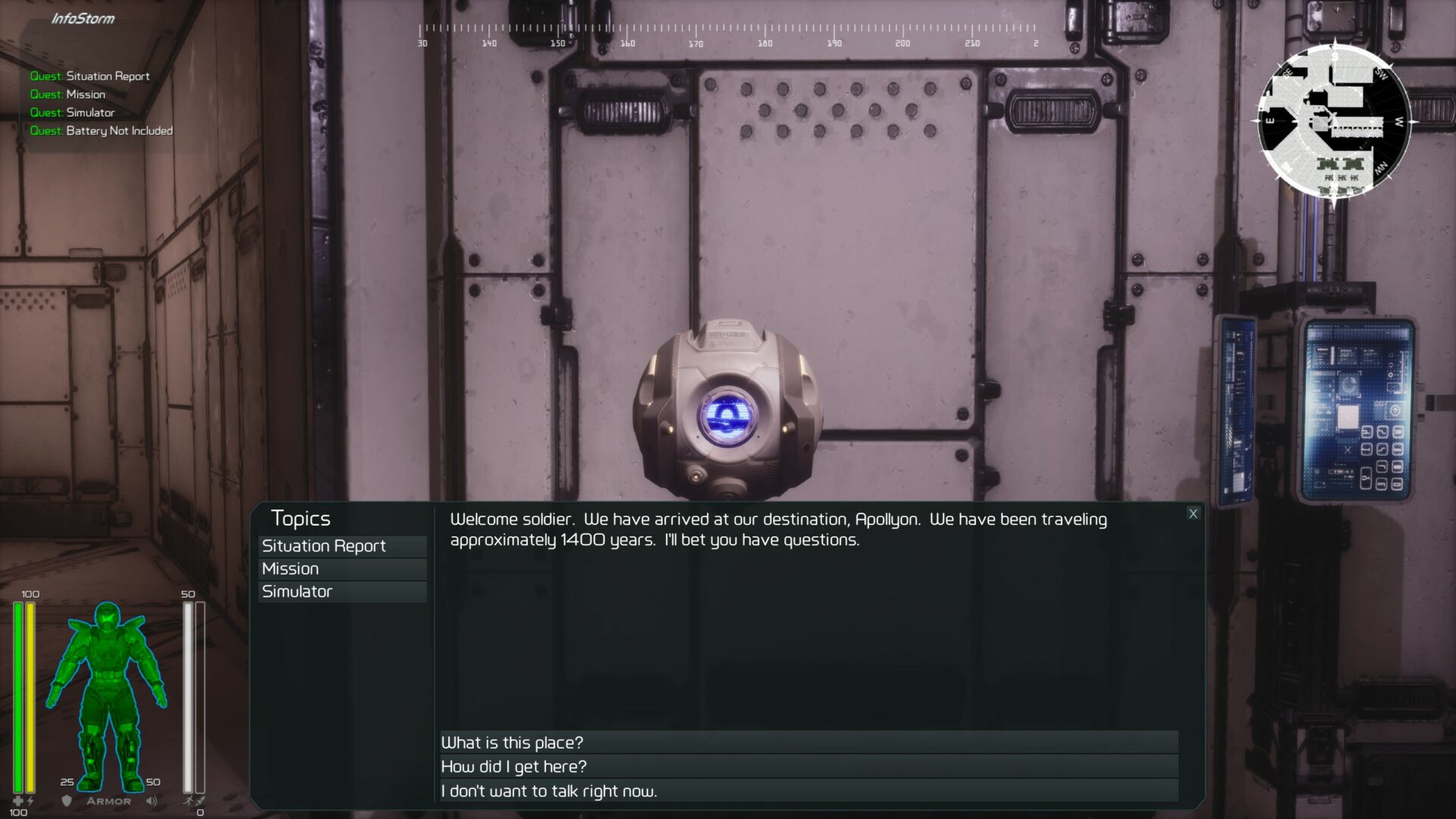
Sights and Sounds
The world of Gearstorm is quite a pretty one. Though the range of trees and other foliage is relatively small, what’s here so far is used to quite good effect, with at least a couple of different species for each of the game’s biomes, ranging from small grasses to huge, towering trees. Indigenous creatures are creative, ranging from peaceful herd creatures like deer, through weird land-crayfish-insect-like things that are truly disgusting, to ferocious dinosaurs that eat you for breakfast. These are all modelled and animated nicely, but more variation is definitely needed across the board.
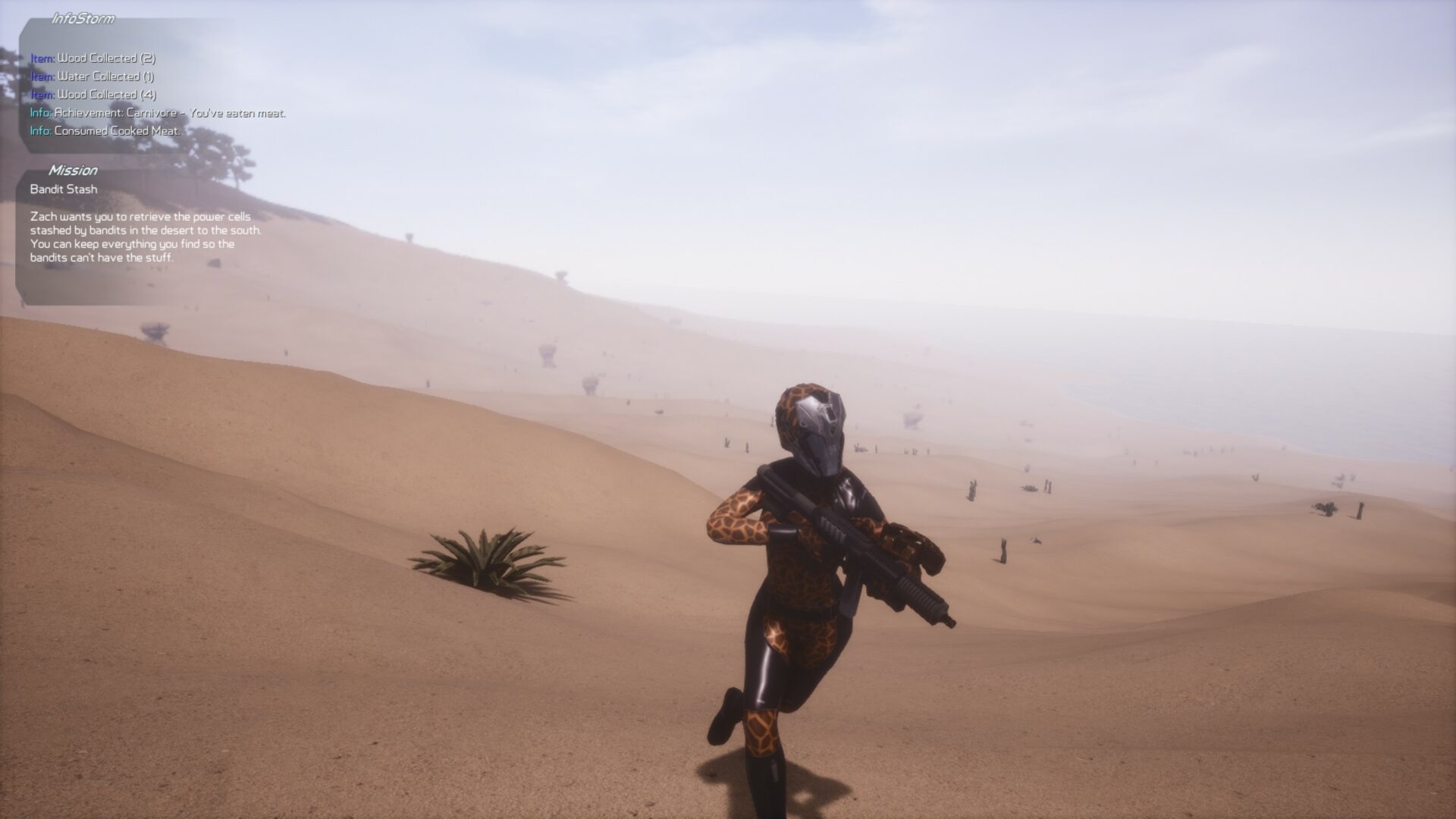
Humans suffer from a distinct lack of variety, with NPCs seeming to be made from the same range of very limited choices available during player character creation. I understand that we’re all supposed to be some sort of space marine clone or whatever, but I’d be happy to suspend my disbelief a little more and have a lot more choice in character appearance than the few shaven-headed men and women available here. Outfits would be nice, too, and given the number of aesthetic craftable items, don’t seem like they would actually be that out of place. As well as the relatively poor quality of the human models, their animations also look pretty naff; I’m hoping this whole aspect of the game is just placeholder art. The weapon and building visual customisations are pretty nice, though, and the freely movable third-person camera is very useful.
There are also some very big visual problems related to the terrain and world objects. For starters, pop-in of foliage is horrendous and unreliable. I encountered instances where I was walking along a big road through a forested area, but turning left and right all of the trees around me would disappear entirely, or only their trunks and branches would disappear, or they’d remain completely visible, seemingly at random. It’s made even worse by having a long visual distance; when you’re up high standing on a mountain or descending in your drop pod, trees and other objects at a distance tend to disappear entirely, only becoming visible in a relatively small radius around you. The same goes for enemies, unfortunately; numerous times I’ve been killed at a distance by an enemy that I can’t see due to clipping issues.
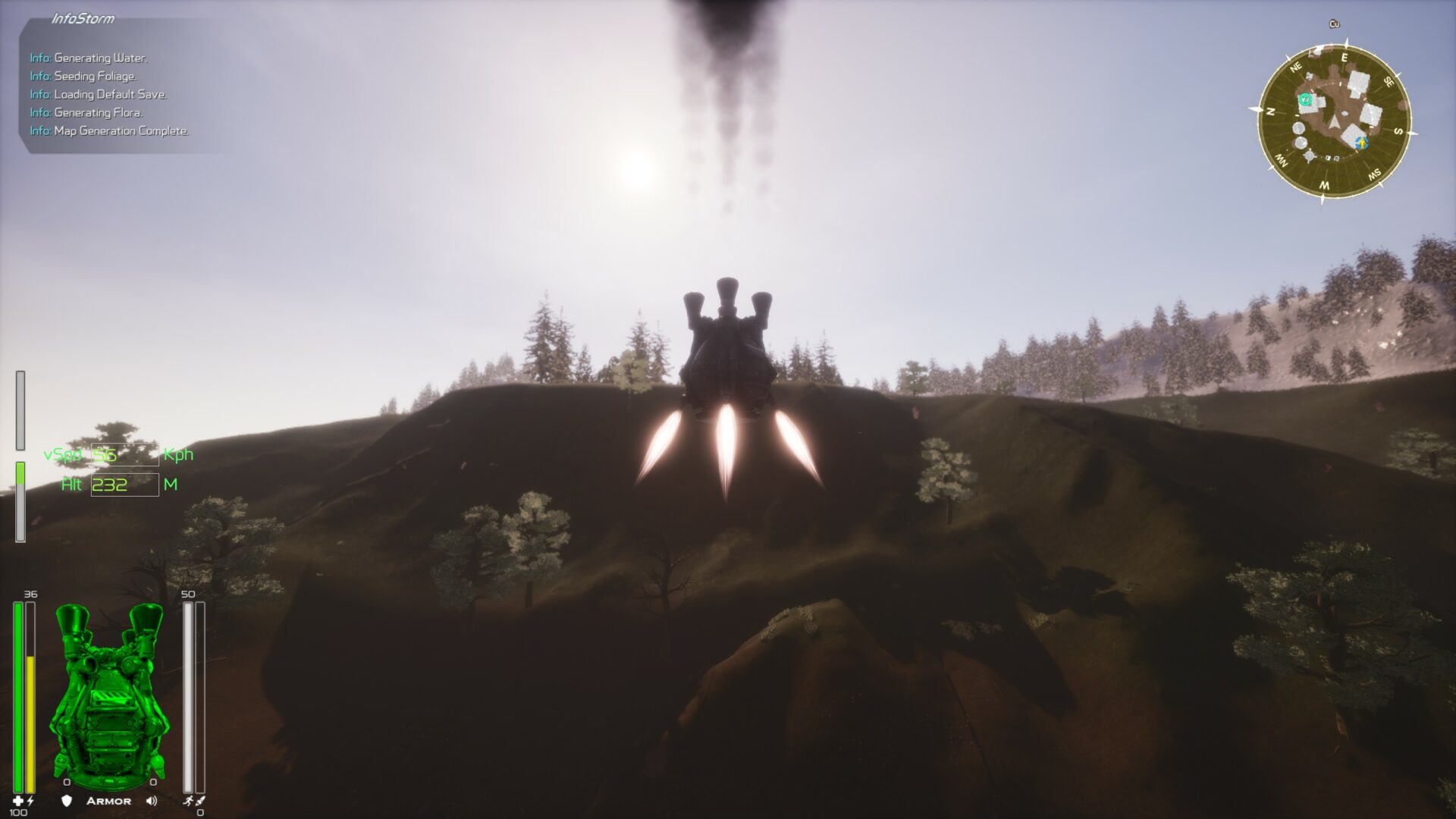
Other visual irregularities include occasional flickering textures, inconsistent lighting, and abnormally sharp polygon edges, particularly when deforming the terrain, and some issues where water meets land, leaving holes in the water mesh and preventing the game from treating a section as being underwater. View distance is very long (reducing FPS appreciably when increased), with a nice haziness at very long ranges, but the middle distance sometimes looks a bit too blurry, too: perhaps a slightly off DoF effect, maybe?
Gearstorm features a very short, but fancy-looking CG video intro with a voice over, but the voice is so quiet and mumbly in relation to the music that it’s really hard to hear the speech, and there are no subtitles. Other than that there are a couple of little CG vignettes when starting out, but that’s plenty; apart from the aforementioned issues with the in-game graphics, they’re basically fine, and the text-based dialogues are all that’s needed to convey the story.
The sound effects and music that are here now are okay, but music becomes quite repetitive fairly quickly, with only a few tracks seeming to be present in the game so far, and the world seems to be a pretty quiet place, with minimal sounds beyond those of combat. I’d like to hear a lot more sound effects in the future, including more ambient sounds — much of the planet is wilderness, after all!
Interface-wise, everything is mostly functional, but there are a few areas where the game lacks substantial features. Item descriptions seem to be limited to single short sentences, shown only in certain interfaces (such as the shop), but impossible to see otherwise. Weapon values are shown when adjusting weapon settings (at least damage, fire rate, etc.), but there’s no easy way to compare or evaluate pairs of weapons, and no way to determine game characteristics for any other items — armour, building pieces, etc. I’d like to see flavour text on every item, as well as detailed game information where appropriate. And a map that can be panned and zoomed easily with the mouse would be a godsend, as would a way to actually pause a single-player game without having to exit back to the main menu.
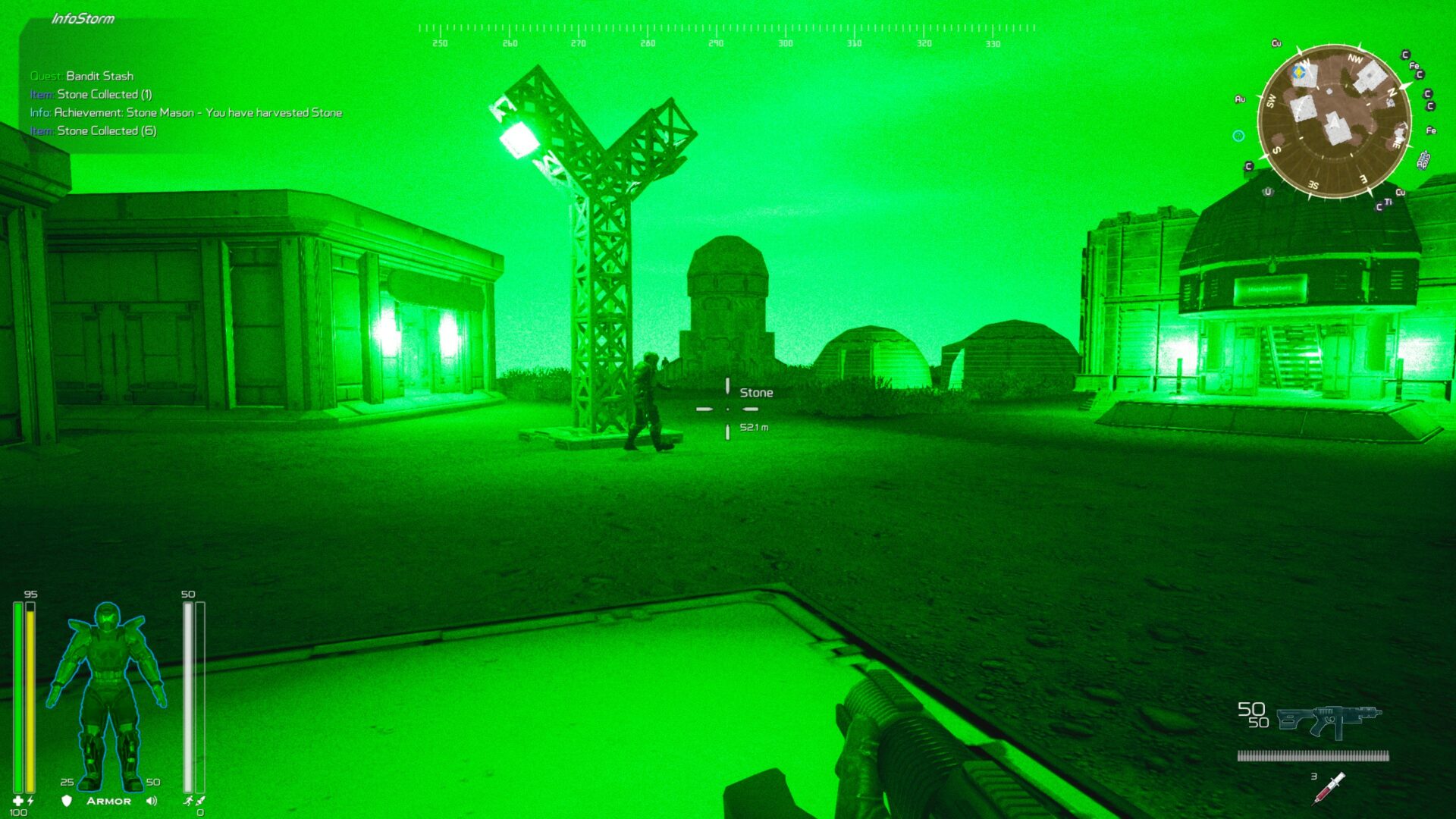
The crafting interface is also very limited, and only accessible through multiple button presses: open inventory, click buildgun settings, eventually find what you want to craft, close settings, close inventory, then hold down the build button. A one-key crafting window would be much easier to use, and some sort of crafting tree or list showing which materials are used with which crafting stations to make which objects would be very helpful, even with only the recipes available now — which I hope will be significantly increased with continued development. What’s here now gets the job done, but it’s hard to use and pretty rudimentary.
The relatively minimal in-game text features a number of grammar errors as well as some silly pop culture references; these triggered more of a bemused chuckle than genuine amusement from me, but they weren’t too painful. Some parts of the UI are obvious placeholders or completely broken: help, for example, is very hit and miss. Performance is variable, with a number of hitches and low-FPS situations, but there’s a good number of graphical options that can be adjusted to fit each system. I’d expect some optimisation work to be done before the game leaves Early Access, though, so this isn’t a serious issue.
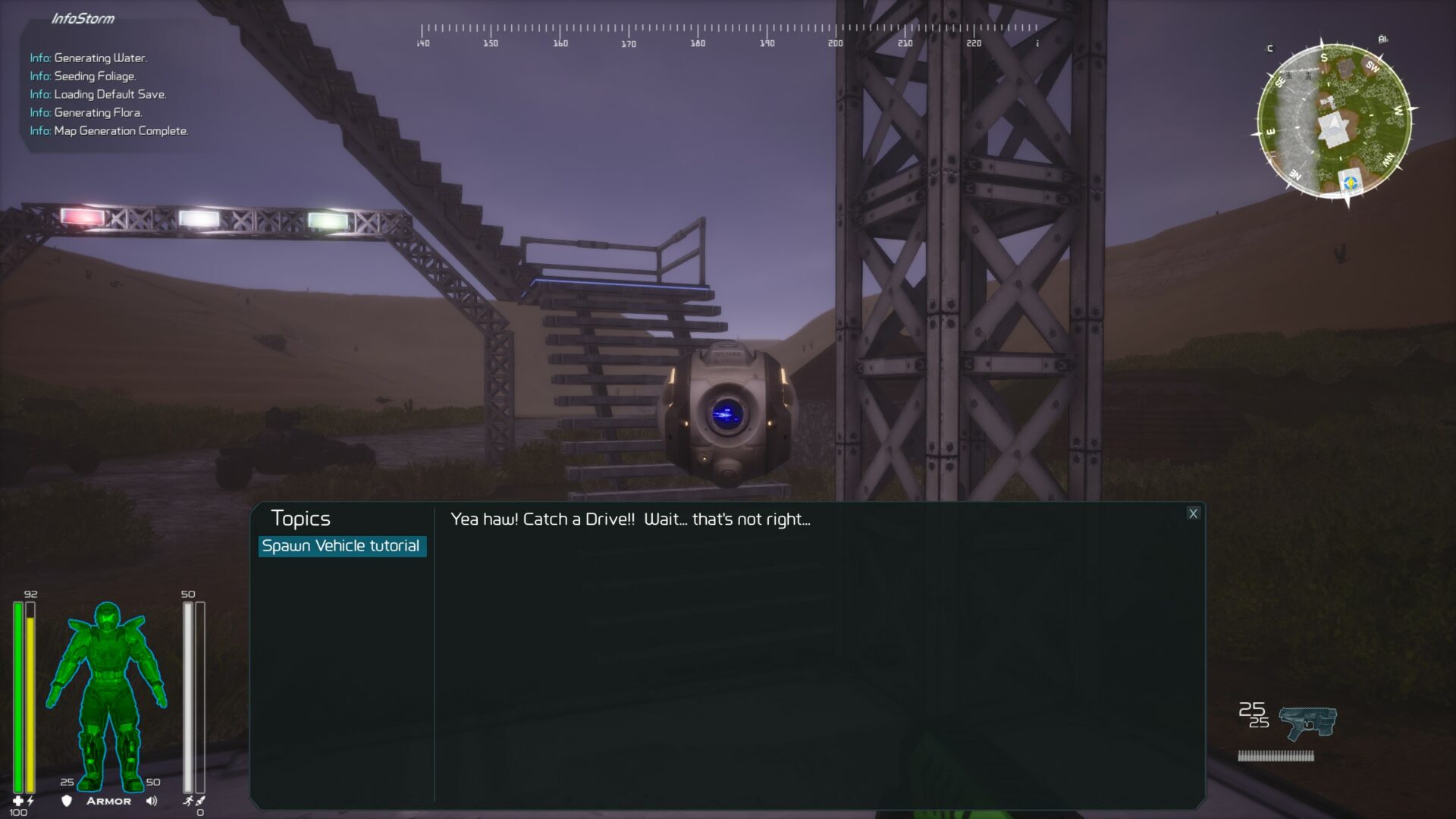
Crafting and Building
Gearstorm sits firmly in the group of games that I like to call survival-crafting games. It has elements of survival, such as food, water, and sleep, but it’s safe to say that in its current incarnation these are relatively limited in importance. Food is only used as a means to recover health in a slower, but more sustainable way than medkits; water is only used in crafting; and sleep is only required once every few days to recover your energy bar. Crafting and building, though, play a much more prominent role in the core gameplay.
As is typical for this type of game, a large portion of game time must be allotted to collecting or harvesting resources and crafting those resources into useful things: weapons, ammunition, chairs, food, armour, walls, ramps, lamps, spawn pads, vehicles, … . The list goes on and on, and, even in its current state, Gearstorm provides a plethora of things to craft and build, spread across multiple tiers of resources, crafting stations, and the like. Many items can be skinned or otherwise modified in small ways, too, which adds a nice customisation touch that I’ve not seen in the genre before.
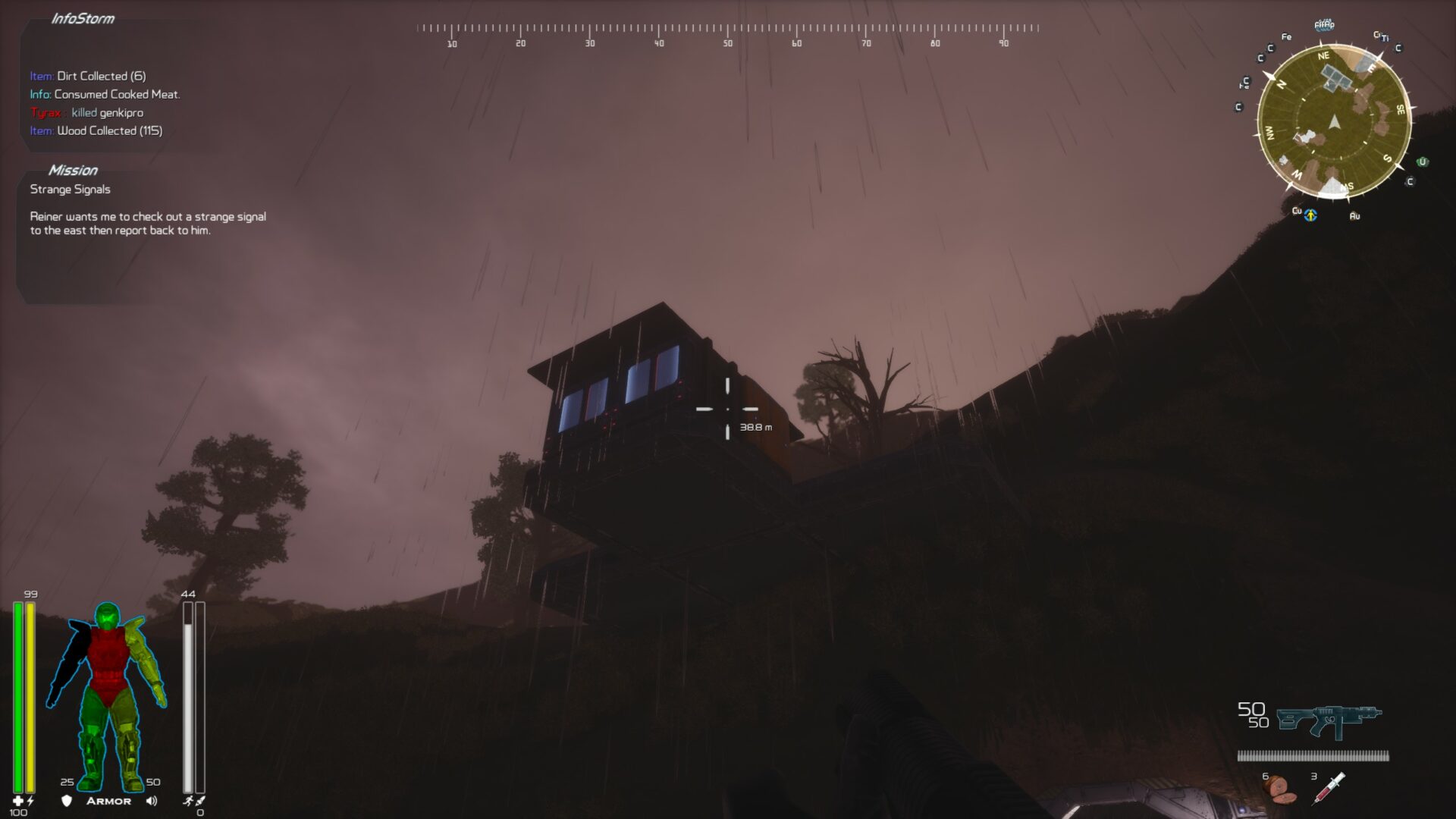
Building is fun and the physical support system (or rather lack thereof) allows for some truly unreal creations, with nearly floating platforms weighing tons balanced precariously from the terrain, and multi-level buildings made up of diverse pieces from vastly different technology levels truly a sight to behold. My first effort resulted in a simple one-room building sticking out from a hill over the starting base, built on a high-tech aluminium and plastic foundation with similar fancy walls and windows, then finished off with a couple of wooden walls, a stone door, and burning torch for light. It looks weird, but definitely interesting!
Other crafted objects are more consistent in terms of technology, with a sort of simplistic plastic and aluminium – based science fiction theme running throughout. That said, the only armour I’ve been able to craft myself so far is made of iron, looking like something out of a mediaeval setting, though strangely there are no similar-themed weapons: no bows, and there are no melee weapons in the game at all. The collection of available vehicles — which are for the most part very cool, indeed — are similarly grouped, with only high-tech tanks, flyers, and ‘mechs’ available. I hope the developers increase the number of craftable objects across the whole technology range.
Some of the recipes seem a bit unbalanced, and a LOT of wood is needed to power most of the crafting stations (made more of an issue because trees don’t seem to respawn at all, though you can get by on a few planters continuously growing cacti), meaning that the grind becomes a bit unpleasant at times, but it’s not as bad as some other games. The fully destructible world helps in this regard, too; digging out mines, tunnels, and the like from the terrain is surprisingly fun. There’s also no character progression, indeed no progression at all, outside of harvesting, crafting, and building. There are no RPG-like characteristics or skills, and no feats or recipes to be learned. The sum of your character is what he or she has collected or created.
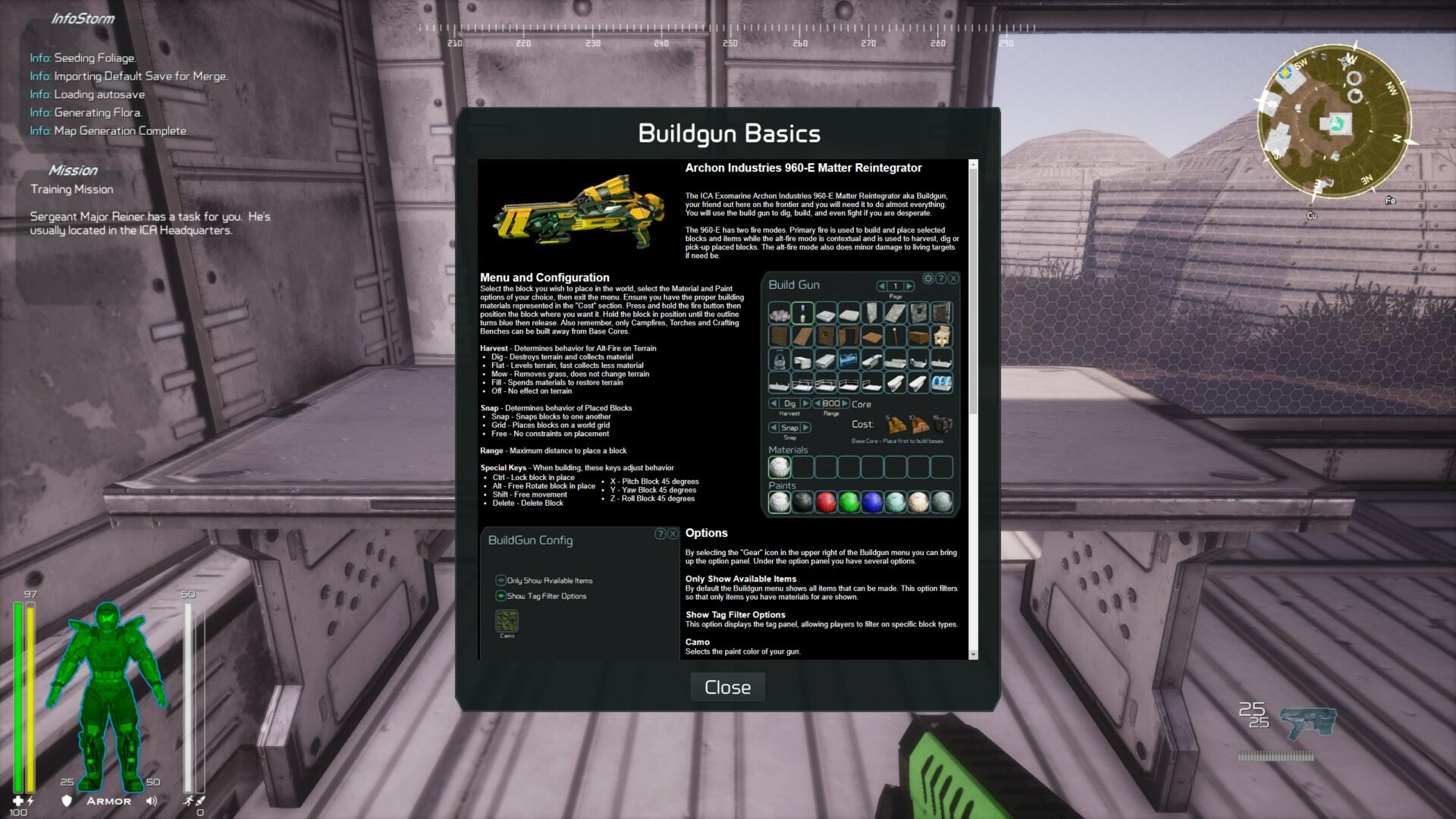
Combat
Other than survival and crafting / building, the other core gameplay element is combat. Given that there’s no notion of character progression or experience, the only benefit to engaging in combat — other than the challenge itself, of course — is to gather the materials or objects that are left behind by fallen enemies. Such enemies are of two types: indigenous creatures, which typically charge towards you and repeatedly attack until they or you are dead, and NPC humans, which are either bandits or “zombies” — humans who have fallen victim to the Phage, which devastated the population of Earth — and either hang back shooting at you with perfect accuracy regardless of distance or intervening foliage, or charge into melee and behave the same as the creatures.
AI, then, is extremely simple, and, together with the often limited rewards to be gained from battle, make combat more of a chore at the moment than an enjoyable activity. There are basically no advanced tactics available to the player, as all enemies are either suicidal melee combatants who you try to pick off as they approach, or perfect-shot ranged combatants (often attacking from beyond clipping distance) who you need to charge at to get within range of your own guns.
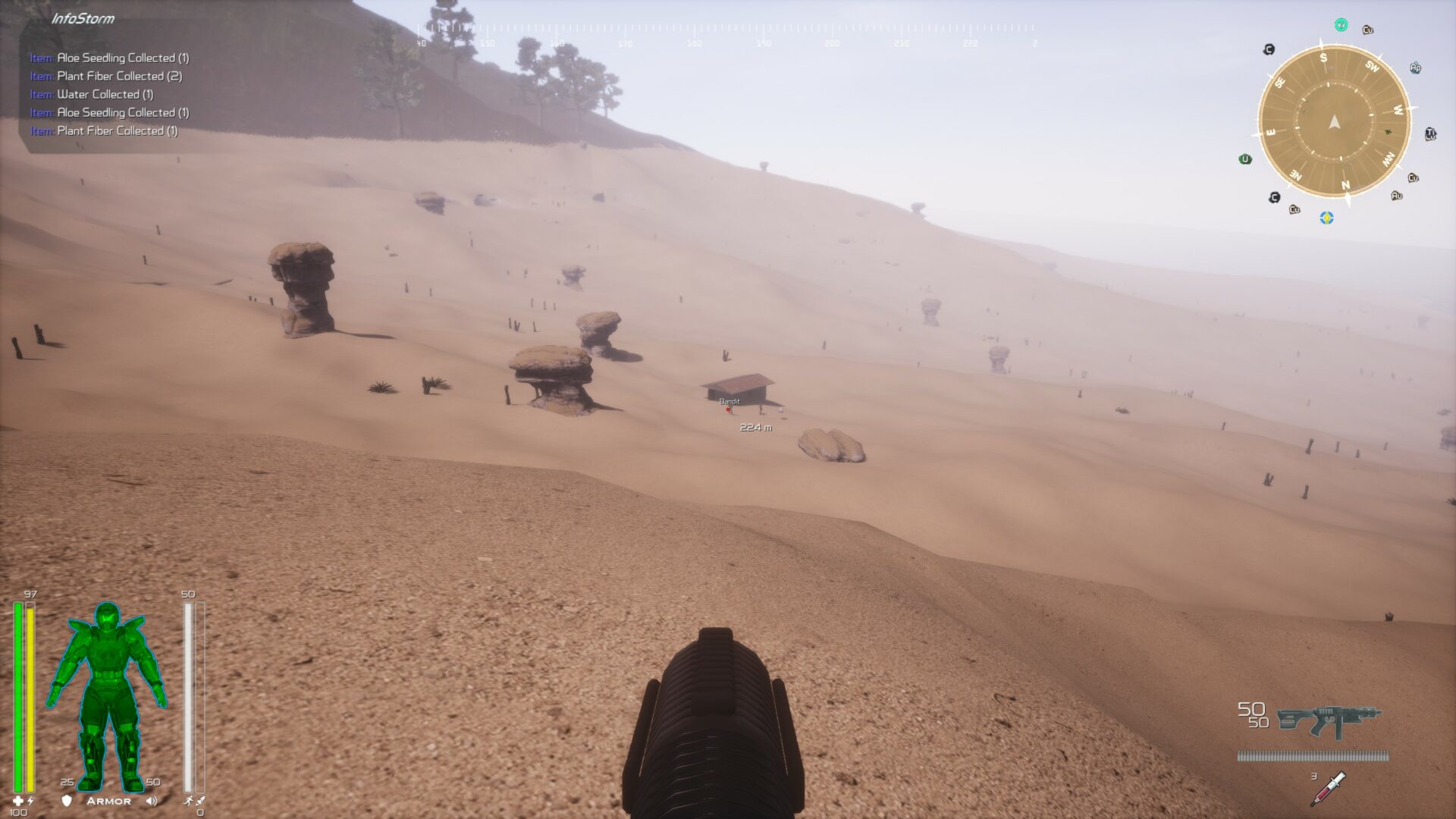
Balance is an issue, too, with the most powerful indigenous creatures often being able to creep up on you with no warning at night and then kill you in one hit. They also never give up following you, which for me made for an entertaining run around the starting base in campaign mode while the other inhabitants slowly picked off a Tyrax (one of the planet’s apex predators; like an alien tyrannosaurus rex); it just kept chasing me regardless of how many people were shooting at it. The only saving grace in this regard is the easy ability to respawn a new clone anywhere on the map, allowing you to plummet to the ground in a new drop pod within spitting distance of your corpse, and thereby recover your dropped inventory easily — as long as the creature that killed you isn’t hanging around, anyway.
In short, combat needs a lot of work to become a fun part of the game.
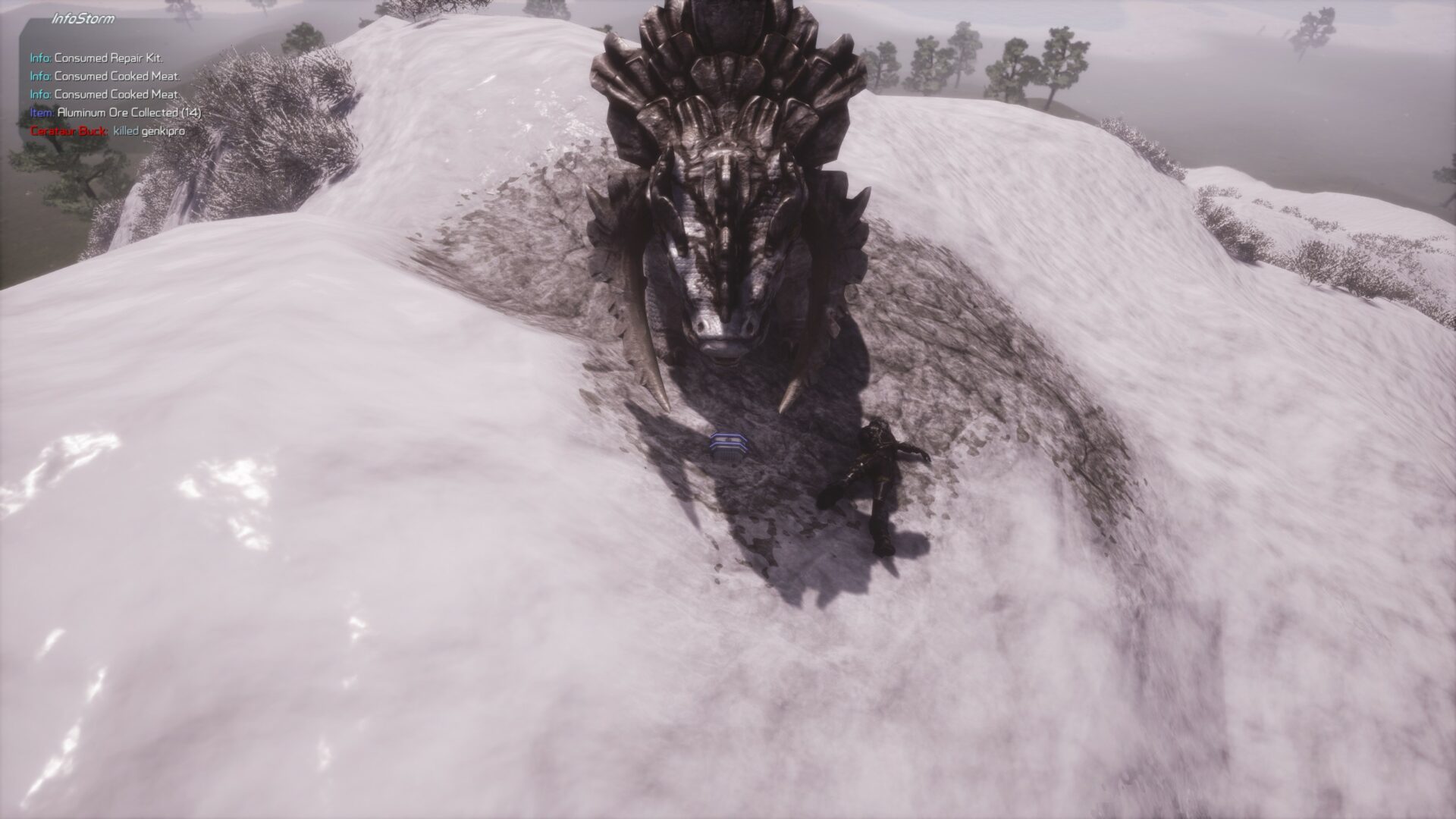
Game Modes
The game already supports single player, local server, and remote server options, similar to what I consider the yardstick for measuring such features in this sort of game: Conan: Exiles. It’s great to see early support for fans of both single- and multi-player games, and private and public servers; often these options are left until towards the end of development and sometimes get left out entirely. If you’re after a multi-player experience, though, at this point you’ll probably want to bring your own friends; during my play time I’ve only ever seen one public server listed and it’s had no other players on it when I’ve been playing.
There are also two modes of play: the Campaign, which provides a gentle tutorial and also introduces you to the world of Gearstorm through a series of missions and objectives, given to you by NPCs; and Survival, which drops you in the world with barely a hint of how to proceed, and leaves you to your own devices. Both modes are only playable on the single (large) island, however, and there seem to be no significant differences that I can see between the two, beyond the starting situation. There are no options for procedural generation or high-level modification of the game world, but you can respawn wherever you like, appearing in another drop pod hurtling downwards through the planet’s atmosphere. In all modes the world seems a bit too empty, though still fun to explore at least once, but I’m hoping more of everything will be forthcoming as the game progresses through EA.
I’ve spent much of my play time in the Campaign, but unfortunately the quest triggers and scripting seem to be unreliable enough that my progress was halted quite early on: Quincy ran away and refused to follow me to Northpoint, preventing any further quests from appearing. Campaign mode doesn’t restrict you in any way, though, so my game simply turned into a sort of Survival mode in which I received a good head start, crafting and building from a fairly solid base.
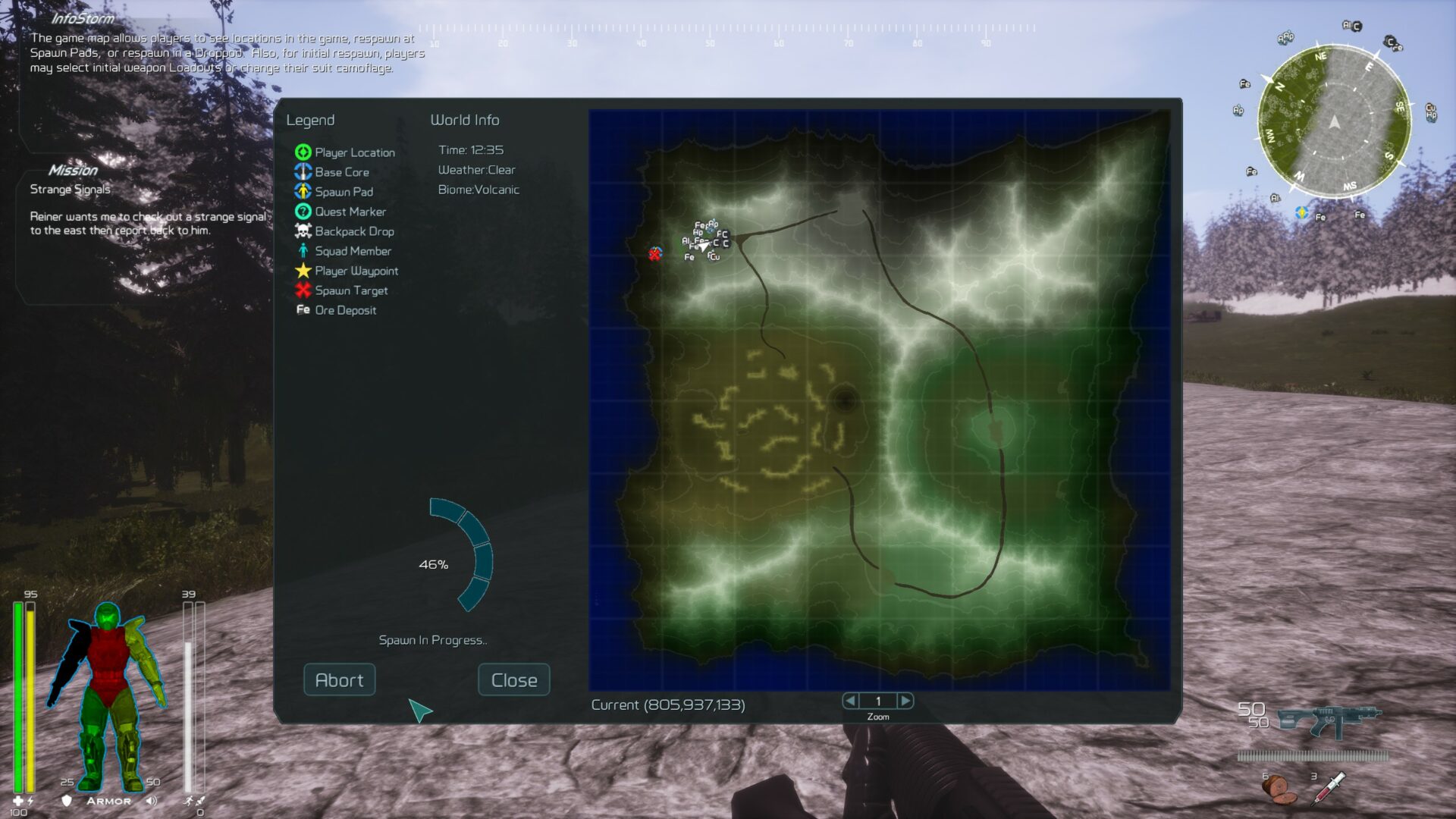
Each game mode can also be started with “game master” functionality enabled. This allows creative types to use the relatively limited (so far), but potentially powerful, game-master tools to spawn objects, create new NPCs with new quests, and so on. It looks like it could be a very useful feature for customising your own server for your friends (or enemies!), but I haven’t delved too deeply into it so far. I have wondered if I might be able to use it to fix my Quincy quest problem, though … .
Verdict
While it’s hard to recommend outright in its current state, there’s definitely enough in the current version of Gearstorm to sink your teeth into. Controls, UI, and various game systems are often clunky; graphics can be unreliable; the campaign breaks easily; the large island world feels somewhat empty, and is hedged in by invisible walls that look terrible and occasionally cause crashes when you get too close; and there’s a fair bit of not-too-well-balanced grind. But the core gameplay is addictive and sometimes even rewarding, and many of the game’s current little niggles can be worked around with a bit of care.
I’d like to see more of everything: more creatures, more crafting and building, more NPC interaction, more customisation, more sounds and music, and so on. But even as it stands, and not including the game-master tools that allow creative server administrators to add their own quests and spawn things willy-nilly across the map, Gearstorm is worth a look.

